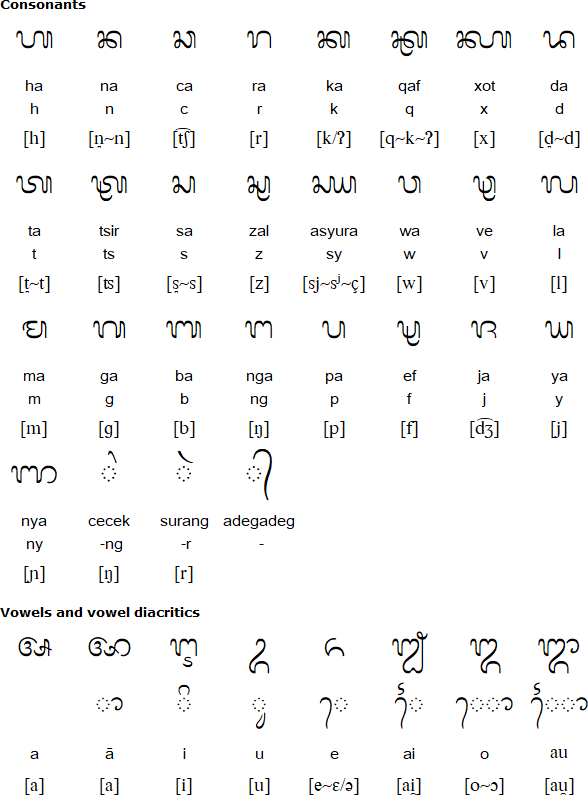Sasak Script on:
[Wikipedia]
[Google]
[Amazon]
 The Sasak script or Jejawaan Sasak is an
The Sasak script or Jejawaan Sasak is an
 The Sasak script or Jejawaan Sasak is an
The Sasak script or Jejawaan Sasak is an abugida
An abugida (; from Geʽez: , )sometimes also called alphasyllabary, neosyllabary, or pseudo-alphabetis a segmental Writing systems#Segmental writing system, writing system in which consonant–vowel sequences are written as units; each unit ...
traditionally used to write the Sasak language in the island of Lombok. It descends from the Kawi script
The Kawi script or the Old Javanese script (, ) is a Brahmic script found primarily in Java and used across much of Maritime Southeast Asia between the 8th century and the 16th century.Aditya Bayu Perdana and Ilham Nurwansah 2020Proposal to en ...
and is heavily influenced by the Balinese and Javanese script
Javanese script (natively known as ''Aksara Jawa'', ''Hanacaraka'', ''Carakan'', and ''Dentawyanjana'') is one of Indonesia's traditional scripts developed on the island of Java. The script is primarily used to write the Javanese language ...
s.
History
According to one hypothesis, theSasak people
The Sasak (Balinese script: ᬲᬸᬓᬸᬲᬲᬓ᭄, ''Wång Sâsak'') people live mainly on the island of Lombok, Indonesia, numbering around 3.6 million (85% of Lombok's population). They are related to the Balinese in language and in ...
have inhabited island of Lombok
Lombok, is an island in West Nusa Tenggara province, Indonesia. It forms part of the chain of the Lesser Sunda Islands, with the Lombok Strait separating it from Bali to the west and the Alas Strait between it and Sumbawa to the east. It is rou ...
for centuries, they are said to have inhabited the areas since 4,000 BC. There is an opinion that says that the Sasak people originate from a mixture of the native people of Lombok with immigrants from Java
Java is one of the Greater Sunda Islands in Indonesia. It is bordered by the Indian Ocean to the south and the Java Sea (a part of Pacific Ocean) to the north. With a population of 156.9 million people (including Madura) in mid 2024, proje ...
, then there are also those who state that the ancestors of the Sasak people were Javanese.
According to Goris, "Sasak" etymologically comes from the words ''sah'' meaning 'to go' and ''shaka'' meaning 'ancestor'. Thus he concluded that Sasak means 'going to ancestral land'. From this understanding it is suspected that the ancestors of the Sasak people were Javanese. Other evidence refers to the Sasak script used by the Sasak people, known as the Jejawaan Sasak script, which is a writing system originating from the island of Java. In its development, this script was well presented by Sasak poets who gave birth to the tradition of Sasak literature.
Based on the origins and use of manuscripts in lontar manuscripts, both in Sasak language and Kawi language
Old Javanese or Kawi is an Austronesian language and the oldest attested phase of the Javanese language. It was natively spoken in the central and eastern part of Java Island, what is now Central Java, Yogyakarta and East Java Provinces, Ind ...
, Jejawan Sasak script is divided into four groups, namely:
*Baluq Olas
*Rekan
*Swara
*Swalalita
The origin of the Sasak script is from the Javanese script
Javanese script (natively known as ''Aksara Jawa'', ''Hanacaraka'', ''Carakan'', and ''Dentawyanjana'') is one of Indonesia's traditional scripts developed on the island of Java. The script is primarily used to write the Javanese language ...
. In terms of pronunciation, there are 20 Javanese letters in the following order; a a a a a a a a a a a ha a a ya a a a ha and ga The letters that were absorbed into the Jejawaan Sasak script only number 18 letters and are called the ''Baluq Olas script'' which in English means 'eighteen letters'.
The Sasak language was originally written with a script called the Sasak script, similar to the Balinese script
The Balinese script, natively known as and , (Balinese language, Balinese: ᬅᬓ᭄ᬱᬭᬩᬮᬶ) is an abugida used in the island of Bali, Indonesia, commonly for writing the Austronesian language, Austronesian Balinese language, Kawi la ...
which was influenced by the Javanese script. The script was written on palm leaves, and then from the 1970s, paper
Paper is a thin sheet material produced by mechanically or chemically processing cellulose fibres derived from wood, Textile, rags, poaceae, grasses, Feces#Other uses, herbivore dung, or other vegetable sources in water. Once the water is dra ...
began to be used to write the Sasak script. Today knowledge of the Sasak script is limited to a small number of people, and the Latin alphabet
The Latin alphabet, also known as the Roman alphabet, is the collection of letters originally used by the Ancient Rome, ancient Romans to write the Latin language. Largely unaltered except several letters splitting—i.e. from , and from � ...
is used instead. In 1948, parts of the Bible
The Bible is a collection of religious texts that are central to Christianity and Judaism, and esteemed in other Abrahamic religions such as Islam. The Bible is an anthology (a compilation of texts of a variety of forms) originally writt ...
were translated into Sasak and there was some literature in Sasak in the 19th century that was heavily influenced by Javanese.
References
External links
* Brahmic scripts Indonesian scripts {{Brahmic-script-stub